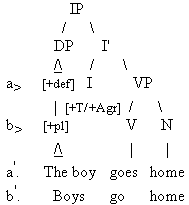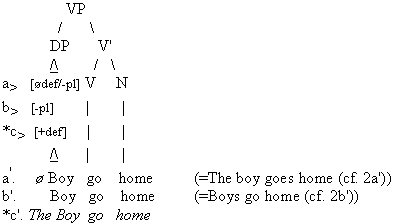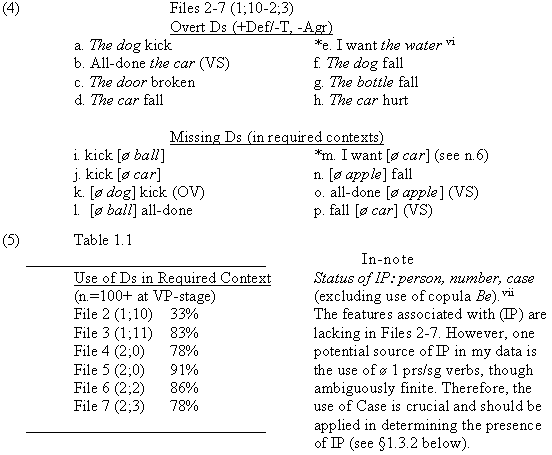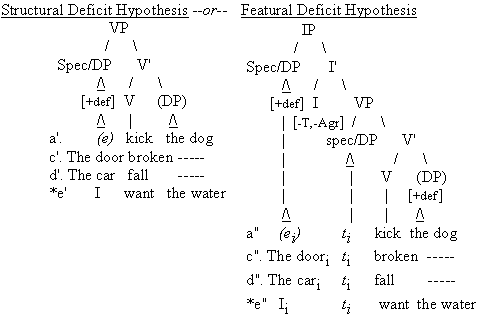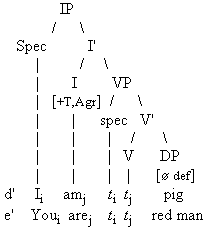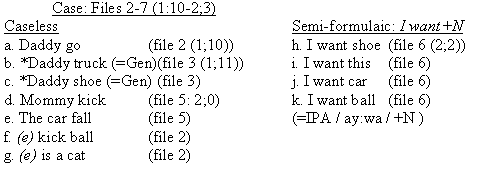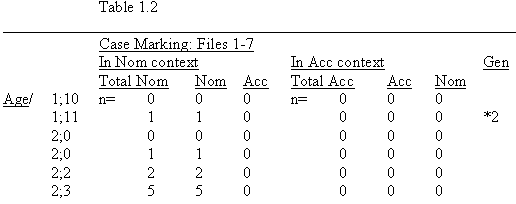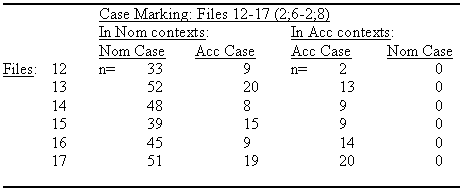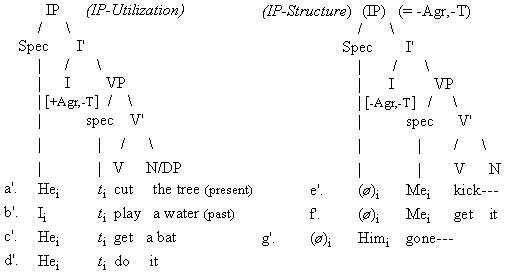
Verbs and Nouns: INFL and the Emergence of DP* Joseph Galasso 2001 (1999) California State University, Northridge 1. Functional Parameterization The study of the acquisition of IP and of the Determiner Phrase (=DP) can help determine whether or not Functional Parameterization has taken place in the child's syntax. Under the current Minimalist Program, formal syntax provides a mechanism for Checking morphological features within specific functional (local) domains triggering movement operations either at post-Spell-out (covert) LF, or pre-Spell-out (overt) PF-levels of representation. For instance, if we assume that abstract Nom(inative) Case assignment is checked under a Spec-Head Agr(eement) relation within IP, Gen(itive) Case is checked via a Spec-Head relation within DP,[i] and Acc(usative) either under a Verb-internal (Head-Comp) relation or via Default, then, a central prediction might be made concerning any possible absence of the functional categories IP and DP in early child clause structure: viz., only instances of Accusative Case assignment (via default) should be notable at prefunctional stages of language development. The following sections examine the acquisition of INFL(ection) along with the role that the DP system plays in the early development of English. In §1.1, I begin by examining the idea that a correlation exists between D and I. §1.2 presents the relevant Data as follows: DPs (§1.2.1), Case (§1.2.2) and Tense (§1.2.3) (Preview) Regarding the early emergence of DPs found in the VP-stage (=DP>VP), we come to the conclusion (following Radford: 1990) that they represent for the child a miscategorized lexical category: i.e., they function in the same manner as their more primitive NP-counterparts. For instance, owing to this miscategorization, Case features that are typically associated with Poss(essive) DPs are postponed until the fully-fledged, well formed DP (=DP>IP) has been acquired--here, being triggered by the productive usage of the Possessive element 's. Regarding INFL, we conclude that a Prefunctional-stage exists (=Stage-1)--viz., a stage where all formal feature specifications are totally absent--before the onset of an (optional) Underspecified-Functional-stage (=Stage-2).The material in this paper roughly
corresponds to my Chapter 4 INFL (see Galasso Ph.D. Essex
1999). For all cited references, see Galasso The Acquisition
of Functional Categories (2003 IULC Press).
1.1.1 Correlation Between D and I Recent arguments have been put forward suggesting there to be a Feature Correlation between the Head features of D(P)s and the Spec features of INFL (cf. Felix: 1990, Hoekstra et. al: 1996, 1996a,b,). The basic premise behind the correlations results in the following conditions in (1) (Hoekstra et al: 1996). (Nb. An alternative and less constrained version of the condition has emerged stating that non-finite clauses may in fact opt for either specified or non-specified subjects (Hyams: 1997)). (1)
The reasoning behind the posited correlation has to do with conventional notions that claim that Subject Pronouns/(DPs), when within a Spec-Head agreement configuration within IP, are to be assigned Nominative Abstract Case. This appropriate checking domain then allows for the checking of formal Agr(eement) phi-features of D (e.g. phi (f)= person/number/gender) to occur between D and I. The conditions in (1) would therefore account for the fact that e.g., the 3sg copula Is requires a 3sg Subject She. The correlation holds owing to the stipulation that all uninterpretable features (in this case, being the 3sg feature) must be checked-off. However, the correlation does not hold indiscriminately--that is, the correlation only holds where it would otherwise result in an uninterpretable feature remaining unchecked (thus resulting in a crashed derivation). For example, consider a D(P) 3sg Subject which lacks a Gender feature--with the 3sg number property along with all other phi-features remaining present. In this case, there is nothing in the correlation that would predict IP to be underspecified for 3sg number Agreement as a result of the DP's lack of a gender property--the remaining uninterpretable features may proceed to be checked and erased (only gender fails to manifest itself). Furthermore, one might wish to extend the above observation regarding an indiscriminate correlation, and predict that a D(P), in principle, could appear within a VP (a non checking domain) projection. In such cases, intrinsic feature(s) of D(P)--presumably those more semantically oriented (e.g., Definiteness)--would be permitted to go unchecked possibly due to the default setting of D itself. In extending this potential default DP to Subject position (say of underspecified IP), we forgo all meaningful operations to the correlation. It is precisely this observation which begs the question of a correlation in general. The above correlations predict e.g., that Subjects of Finite clauses should be overtly marked for Agreement/Definiteness: i.e., Finite verbs--I specified for T/Agr--should trigger Plural Nominals (e.g., if the verb is plural) or Nominals with overt D as in (2a,b) below (Radford:1997ms (simplified by ignoring Spec-VP)): (2)
(Nb. Henceforth, conflated trees should be read as follows: the arrowed-letter (e.g. a> ) indicates the exact feature involved, while the primed-letter counterpart (e.g. a'.) represents the token example expressing that feature) In contrast to (2), Subjects of non-finite clauses should have bare nominals without their counterpart Determiner and Number specifications as in (3 a,b) below: (3)
The absence of the determiner with a singular count noun (cf. 3a) might be analyzed in two different manners: (i) it may either indicate the failure to mark number; or rather, (ii) it might indicate the failure to mark definiteness. One interesting thing to note here, and something I wish to emphasize, is the notion that a DP containing an overt Det (specified for definiteness as in *3c) might be potentially analyzed as the Specifier (in-situ) of a Lexical VP (a somewhat demoted analysis given that the child's acquisition of DP is commonly viewed as marking the Functional-Stage of language development). In this sense, theoretical correlations which place the acquisition of D(P) Subjects with that of IP, need not necessarily apply (compromising 1b above). Radford (op.cit) invokes such a principle by suggesting that a Determiner, when seemingly associated with a vacuous/non-specified IP (e.g. -T/-Agr), might simply take-on a default Objective Case status.[ii] In addition, if checking were involved, the DP could possibly be assigned Objective/Accusative Case via a Structural relation with the Verb (VP-internally). The possibility of a Default Determiner, however, complicates issues surrounding the classification of DP: typically speaking, DPs are considered to be a functional category (cf. Fukui 1986; Abney 1987)--it is in this vein that a correlation with IP is naturally intuitive. However, the above default analysis of Subject DPs rather undercuts the issue of classification and leaves open the question of whether or not a (straightforward) correlation necessarily holds between D and I. In other words, all aspects of the correlation may hinge entirely upon whether or not D(P) is in Spec of IP (=DP>IP) or Spec of VP (=DP>VP)--so complicating matters. On Empirical grounds, the relatively early emergence of D (as seen in my data and in various data in the literature) as opposed to the protracted emergence of the full-fledged IP, can be accounted for in quite independent manners--an observation strongly favoring the opinion that no necessary-correlation exists. On Theoretical grounds, there traditionally exists a handful of differentiating characteristics found amongst Functional and Lexical elements (see Abney 1987: 64f). Abney, among others, has suggested that there might be some reason to speculate on a dual status for DP's function: i.e., in addition to maintaining their traditional Functional-categorial role--a role which may indeed correlate D to I, DPs might also play a semantic Lexical-categorial role--a role which typically pertains to categories lower down from IP in the structural tree. A number of arguments might go as follows:
Regarding this possible distributional asymmetry of D, Chomsky's claim here would suggest that under the more formal D-feature account (DP>IP), substantive references of Ds must continue to be supplied nevertheless, in some other manner in the semantics (presummably at (or even above) LF). This amounts to saying that after any checking-off and deletion of formal D-features, the reference of D itself must remain visible at LF for reasons having to do with its substantive/semantic nature (Chomsky 1995: 279). This leaves opening the question of whether or not [+Def] may nonetheless be active in a (DP>VP). (See below for an expanded treatment of this regarding [-/+Interpretable] D-features.) The above arguments are tantamount to readdressing outstanding issues regarding the analysis of D. Firstly, if we assume the DP-analysis (cf. Abney), it remains unclear whether or not a determiner (e.g., The) should be analyzed as the Head (D) or Specifier of a DP. Secondly, an NP analysis for D still remains an option. An example of a similar dilemma is illustrated in Radford (1990: 68ff) who claims that early possessors--like determiners--are in Spec-NP (e.g., Mommy car, Dolly hat, etc.) and not in Spec-DP. This analysis gives him a readily available account for the lack of Case (genitive 's) for such examples--i.e., the Case Filter was seen as being inoperative due to the lack of the case-marking functional category D. Attempts to redefine the nature of DP via its maximal projection and not by its inherent properties have been recently reported in Language Acquisition literature. In fact, two independent bodies of investigation--out of a small handful cited in the previous chapters regarding literature review--claim such an interpretation for DP on both empirical and theoretical grounds. Theoretically speaking, Meisel (1994, 1995), while writing on Language Mixing, states that only those functional categories that universally host verbal elements (viz., IP and CP), as opposed to functional categories that host strictly nominal ones (viz., DP) obey Functional Constraints on Mixing. Meisel goes on to give empirical evidence that DPs (within VP environments) have nothing whatsoever to do with language specific awareness. In other words, language mixing/code-switching that incorporates such DPs violated all known functional constraints on mixing. (See Chapter 6 on Code-Switching for a full discussion). Hence, DPs might not function in such a strict manner typically associated with Functional Categories. Paradis et al. (1996) likewise have claimed recently that the Definite DP system emerges relatively early in their data, coupled with the complete lack of any other type of functional projection. They give ample evidence to suggest that DPs and IPs are acquired independently of each other--e.g., a Det could be omitted in a finite utterance and a nonfinite utterance could contain a Det (op.cit: 25). In sum, Abney's (1986, 1987 op.cit.) important observation stating that functional categories generally tend to have affixal natures--i.e., tend to be bound morphemes which are attached to other categories (mostly lexical)--might be reexamined in the light of recent reports of the distribution of DP. In addition, Chomsky (1995: 349) makes clear the notion that among the functional categories (T, C, D, and Agr), it is only Agr which can bost of being free of interpretable features: T, C, and D having interpretable features which provide instructions at interface levels. In this broadest sense, Agreement--encompassing all notions of Case--is the formal category par excellence. Specifically speaking, English DPs (CPs as well) tend not to fall systematically into the affixal distinction (owing to their quasi-substantive make-up)[iv] and, as a result, might well be classified as having a dual status: (i) a lexical-category status (i.e., having an objective/default value) when projected from a Spec of VP (=DP>VP); (ii) a functional-category status when projected from a Spec of IP (=DP>IP). More concretely, the above observation regarding the grammatical properties of DPs--i.e., the grammatical features which play a role in the syntax of a Spec-Head Agreement relation between the Subject and the Verb--might be further expanded into notions of an asymmetry found between phi-features and Case (Chomsky 1995: 278). Suppose Case differs from phi-features in that Case is always [-Interpretable]/ [+Formal]--hence, in need of checking. Suppose (grammatical) phi-features are indeed [+Formal], though with an added stipulation that they may also be [+/-Interpretable]. The most likely candidate for a possible (D) [+Interpretable] phi-feature would seem to be Definiteness: this is based on its more semantic-pragmatic referential properties. In principle, this may leave the remaining (D) phi-features (e.g., gender/--and to a lesser degree--person/number) as possibly deriving the features: [+Formal/-Interpretable]--hence, in need of checking. (Nb. caveat: At the moment there seems to be no straightforward consensus on which phi-features constitute as an interpretable feature--just as there equally seems to be no consensus on which formal features have semantic properties. Nonetheless, we shall consider here Definiteness as foremost in pertaining to such intrinsic semantic properties. This judgment is based on data which tend to show that children universally acquire [+]Definitness--the "concrete-volition" here-and-now--way ahead of [-]Definiteness--the "abstract" there-and-then. Furthermore, the latter phi-features, unlike +Def, may very well consist of feature-properties that have to be checked on the corresponding functional Verb.) By further pursuing this notion that definiteness is [+Interpretable], we can begin to reconcile our ideas that some Determiners--those carrying only the [+Interpretable] definiteness feature and no other phi-feature--may be reduced to having an objective and/or default status: the idea being that such Ds might maintain some sort of inherent case given by a thematic V is also viable. 1.2 The Data 1.2.1 DPs Empirical support for the above analyses of Definite Subject/Object DPs is widely borne out in my own data.[v] The Determiner system for Definiteness is reported to emerge in the very earliest Files (starting with file 2: 1;10). The fact that they emerge on the scene way ahead of any unambiguous Finite INFL(ection) suggests there to be no correlation between the emergence/acquisition of Subject D(P)s and IP (See Data: Stage-2 below for arguments against any possible correlation between Object DPs and INFL). The findings suggest that children come to realize that the case-feature of D can be optionally applied in syntax--when it lacks Case, it is spelled-out as a Default Case form (in either Subject or Object position)--with no other phi-feature being specified. Consider some of the earliest token Ds found in my corpus (while keeping in mind that, at the same stage, Ds are frequently optionally omitted):
Regarding the feature specification of The in (4), it seems to be the case that only the definiteness features has been acquired--for instance, number and case don't appear in the early Files (2-7) as stated in the in-note above. (The first marking of plural "s" doesn't emerge until well into the later Files). Firstly, consider the feature Case. The most natural way to determine if Case had been properly assigned to The (Spec of DP) would be to examine if the Head V(erb) is correctly spelled-out for its Spec features. For example, consider the following sentence: The boys are reading the books. The Spec-features of the Head V(erb) are requires a Nominative specifier for its subject: e.g., ARE [Spec=Nom]. In this sense, it is clear that the DP The boys must carry Nominative case--if it were to carry Objective case, the derivation would crash: e.g., *Them are reading the books. Hence, it remains a feature of the Head (V) to determine if the case requirements of a Spec (D) are being met. The token examples in (4) cannot maintain whether or not case is specified in the above sense: all forms of verbs taken here are non-specified in all the crucial areas (i.e. the Spec features of the Head Verbs in question do not contain the relevant feature specification. Secondly, consider the features number and person. They too rely on the Head V(erb) to determine the features--again, examples in (4) don't suffice. Taking the same sentence, the DP The boys must also carry [3Pnom] since the verb are indicates P(lurality): e.g., *The boys is... The 3person/plurality can be easily demonstrated via the binding of an anaphoric reflexive: The boys read themselves /*ourselves/yourselves to sleep. Although the above analyses seem innocent enough, they don't naturally follow from out of the intrinsic make-up of DP itself: DPs can variably consist of either Nom or Obj case (cf. The boys read vs. I read to the boys) singular or plural (cf. The boys vs The boy). However, interestingly, regarding 3person, there seems to be no other variable option for DPs (cf.*The boy am/are) DPs are intrinsically 3person. In consideration of the lack of number and case features, The would seem to be underspecified both for phi-features and case--with the sole exception of the feature [+Definiteness]. Such a sweeping underspecification of phi-features and case brings us to the question of how to analyze such structures. Suppose we are correct in stating that only the [+Def] feature appears on the early Ds in question. We then could run the two possible stories alluded to earlier, suggesting the following (taken from (1) §1.1, restated here as 1-prime): (1')
This amounts to saying that The always appears as a Specifier of DP in spite of all other underspecifications--dispensing with the alternative notion that The may remain in Spec of NP. The notion that Definiteness is well established relatively early in the child's development increasingly favors the notion that interpretable features of items come on-line at the onset of the early two-word/multi-word stage. Tense and Agreement Inflections on Verbs/Aux emerge around File 8 (2;4). The total count of [+Def] DPs numbers well into 100 tokens (starting with files 2-7). (No Functional Categories) Though one might think that the No Functional Categories (=Structural Deficit) approach would analyze examples (4i-p) as simple VP projections (since no functional categories are visible), examples (4a-h) could, however, be potentially analyzed as IPs owing to the presence of D(P). (Though recall that the very few early nominative constructions here (cf. *e) were considered as semi-formulaic in nature: e.g., "I want+N" (see note 6)). Based on an extreme and highly oversimplified view of the correlation, one could build a case, appealing to the Featural Deficit approach, suggesting that all clauses containing a D(P) must be considered as potential IPs--notwithstanding some feature non-specification of I--since functional categories (here being D) have come on the scene. Such views, I believe, rely on a confusion that all types of Ds--regardless of their featural specification--must involve movement to a Spec-Head configuration within a Functional Category--be it I or Agrs, Agro.[viii] Chomsky (1995: 262), however, is clear on this point regarding the biuniqueness of the phi-features of DP: regarding movement, although it is the case that all formal features of D(P) must involve movement into a functional domain (for checking purposes), such movements do not necessarily apply 'across-the-board' with respect to those ordinal categorial-features of D. In this sense, the ordinal phi-features of D resemble phi-features of N and don't require checking. Though Chomsky asserts that a sort of pied-piping applies activating the entire DP to move along with one or a number of its formal phi-features (presumably case is the leading motivation for movement), such pied-piping of the category works only when a formal feature of the category is obliged to move in the first place. In other words, nothing should force a default or inherent-cased DP to move, since none of its formal features are present requiring checking. This, in fact, is the case of a DP with only its [+Def] features specified (cf. DP>VP). In light of this, the same debate arises in how to accommodate (i.e., keep with principles of Economy, etc.) a seemingly functional category (DP) stripped of its formal features. Demonstrating potential pitfalls, consider how such inert-DP constructions (ex. 4a-h) might be analyzed via the two hypotheses under consideration: (4')
It is clear that a parsimonious VP-projection suffices in handling the lexical material in (4'a-e). Specifically, the VP analysis does not require the added (superfluous) stipulation that all clauses are obliged to project from a IP regardless of whether or not their Spec/Head has any lexical content. The above VP analysis of a DP +def,-f/-case] could be taken as having a Default Objective status (cf.§1.2)--paralleling the following structure where the DP carries the default/Objective case: (6)
It is clear from (4 & 5) that (1b) cited earlier cannot stringently apply--this is taken from the above observations in (6), which demonstrate that specification of both Subject and/or Object DPs for Definiteness may endure even within 'underspecified-for-finite' environments. However, it must be clearly stated that in accordance with Structural Uniformity, once an IP-projection is acquired, we must take it for granted that IPs are henceforth always projecting--notwithstanding underspecifications pertaining to certain INFL-related features. This amounts to saying that the child should never exhibit a lexical VP-stage simultaneously with a functional IP-stage (in what had once been described in the literature as a sort of bigrammaticality): once IPs project, the "VP-stage" is left behind to dwindle. (But see Radford 1990: 290 for questions raised along these lines.) However, a similar fundamental issue remains outstanding here. Specifically, how can we reconcile our VP approach here in light of recent remarks (Chomsky 1995: Ch.4) which suggest that all clauses are to be (minimally) assigned an abstract T(ense) via a T-operator (also see §1.2.2 below). This view was raised with respect to the notion that non-finite verbs in adult syntax are tense-bound--i.e., c-commanded by a T constituent. While The Feature Deficit proposal escapes such problems by claiming that the entire structure of the clause is available in theory--including a T-operator, The Structural Deficit proposal needs a further argument in its defense since all lexical VP-clauses certainly would lack an overt T-operator--otherwise, how would we account for the obvious empirical lack of tense in VP-clauses? In defense of the Structural Deficit view, one could arguably assert that Functional Categories are introduced into derivations either by a PF merger operation or by an LF merger operation (p.c. Radford). In other words, at the pre-functional/thematic VP-stage of language acquisition, the T-operator (or T(ense) P(hrase)) could be present and functioning at LF, but not at PF. (Wexler's OI-stage would then result due to variable TP alternations at LF and/or PF. Moreover, it is not implausible that the two halves of an IP may be split via truncation--with AGRs being projected into PF and TP into LF. (Also see §1.2.2. for a treatment of a split INFL)). (Null DPs) While the above section examines the early emergence of DP, it remains incumbent on us to account also for the apparent lack of DPs in required contexts. It was noted in (5) (Table 1.1) that e.g., (file 7) had 78% correct overt Determiners--this obviously translates into the fact that 22% were also omitted. Moreover, the fact that Null/Non-specified DPs occasionally do co-occur within the overall (unambiguous) IP phrase (e.g. with Nom Case, Finite Verbs (cf. 7d-f), I think, lends additional support to the notion that no general correlation exists between the Head features of Subject-D(P) and Spec of INFL. In accounting for Null DPs, the present model being envisioned here would maintain that D, similarly (and independent) to I, can undergo (autonomous) underspecification of its D features. Hence, as a consequence, erroneous Default/Objective Determiners (cf. §1.3.2 ex.14' for genitives) as well as a total omission of D itself may ensue. Consider the following token examples that show Null DPs: (7)
(7')
The above analyses suggest that Def(initeness) is non-specified (ødef) (=having no specific definiteness properties (Radford: class lectures)). This was taken as a natural extension of Hyams' account that sought to formalize the feature specification of D. The argument follows from the observation that the Definiteness Paradigm involves a Ternary setting: (i) [+def] (The boy), (ii) [-def] (A boy), (iii) [ødef] (boy). (Longobardi (1994) has argued that predicative nominals--in the sense of (iii) [ødef]--can be NPs, contra the general DP-analysis as espoused above.) It is important to note here however that no consequential implications emerge out of analyzing such missing Ds as Null DPs (rather than simply analyzing them as bare Nouns/NPs). This follows from previous analyses (cf. §1.2) which suggest that no general correlation holds between IP and DP--that is, DPs could be equally analyzed as a functional category (whenever associated with IP) or, alternatively, as a lexical category (whenever associated with VP). In this broader sense, nothing is theoretically lost by analyzing them as Null DPs, and, child-to-adult Continuity is achievable at no expense. A number of complications arise from the above cited non-correlation. For instance, as in the adult syntax, the child's syntax can generate those specific features that fall under the D node: e.g., definiteness/case/number/ person/gender. However, unlike the adult syntax, in child syntax one or more of the feature specifications can remain underspecified. The lexical entry specifies the features which items can carry--for instance, suppose The= [+Definite]. This amounts to saying that whenever the lexical entry The is inserted under the D node, only the definite feature will be present: i.e., the +Def feature will manifest irrespective of number (plural or singular), gender (masculine or feminine), or case (subjective or objective). (I leave open here the issue of whether or not The/A carry inherent third person or is personless. Similarly, although A= [-Def, singular] its distribution of features would remain similar to The as stated above.) In the above sense, The strictly means "presence of definiteness", but may tell you nothing of the specification of other possible features--[+Def], being the sole feature of the child's lexical entry, will not identify with those features that remain underspecified within the D node. The above notion of feature specification should lead to a number of predictions. First, the absence of the child's Determiner (The) should always mean the underspecification of Def. Conversely, its presence should always indicate Def. Second, regarding the specification of number--as it is related to D--count nouns may carry number while still being underspecified for Def. For instance, when a child omits a determiner and says I want car (cf. 7a), car may only be marked for number. (The same distributions of feature specification would likewise hold true for the possessive "s" under the D node for genitive constructions (see below)). 1.2.2 Case INFL/Case reports taken from my Data-base suggest there to be Two Developmental Stages of Case assignment: (i) An early, predominantly No-Inflection/Caseless-Stage--where mostly nominal elements are used,* and (ii) An Optional-Inflection/Case-Stage--where Case assignment is seen as fluctuating between two usages: a. Nominative vs. b. Accusative (default). (Stage-1) The main characteristic of Stage-One is the evident lack of any overt Case assigning Agreement (or Tense). Specifically speaking, all of the utterances found in files 1-7 use either (i) Caseless Nominals, [N+N] Genitives (cf. ex. b,c),[ix] or demonstrate some sort of Semi-formulaic Nominative construction (see note 6); while (ii) Tense Inflections (e.g., 3per/prs. +s, ed) are left omitted (see §1.2.3 for Table). Consider the following token examples taken from files 1-7: (8)
(8')
* A total number of 9 Case (stereotypic) constructs were reported among Stage-1 files: 1-7 (1;9-2;3), all exclusively showing "correct" Nominative Case contra the relatively late emergence of Accusatives found in file: 11 (2;5) (see note 6). (Acc Case typically is the first case realized by the English speaking child.) In examining the data, it is indeed very difficult to determine whether or not the child has developed any sort of Case System at all in these early files. It is however interesting to note that the data differ somewhat from Radford's and Vainikka's findings (op.cit.), in that (with my data) no Genitives or Accusatives seemingly appear at stage-one (correctly or incorrectly). (Recalling that Radford reports the first emergence of Case to be predominantly Objective/Accusative with some sporadic incorrect usage of Genitives--I might liken such a stage to my stage-2 (optional infinitive stage) as described below.) The semi-formulaic strings of Nominative ["I want" +"Noun"] likewise remain inadequate for the determination of Case here. These frame-utterances seem to be unanalyzable strings. One very interesting correlation which seems to verify the formulaic make-up of such strings is the observation that no Accusative/Genitive Case errors are seen to emerge in this first stage (other than the two reported above with asterisks for File 3). The observation that the stage is predominantly "error-free" increases the plausibility that, indeed, no real case system has yet been assimilated (the fact that abundant case errors emerge with File 8, I think, eventually signals the real onset of a formal case system for the child). Similarly, the emergence of what otherwise seems to be evidence for an IP warrants some scrutiny. All instances of the early Copula Is (cf. 8g--numbering four in all) make-up formulaic Copula+Subj (VS) orderings and entirely lack any productivity. (see note 7). Following, then, the notions previously laid out in Chapter 1 regarding e.g. Principles of Economy of Representation (Chomsky 1989), Minimal Lexical Projection (Grimshaw 1993a,b), etc.; the No Functional Category/Structural Deficit Approach (cf. Radford, Vainikka, Rizzi) seems to be the most plausible alternative in describing such an initial Caseless stage. Otherwise, we would be forced into making a number of unwanted assumptions: most notably--given a full-fledged Case system is attributed to IP--the unwanted assumption would be that all phrases (IP, and possibly CP) would equally project regardless of whether or not their Heads are lexically (or vacuously) filled. It is at this juncture, and for the above stated reasons of Economy, that we adopt the No Functional Categories Hypothesis for describing our very earliest Stage-1 (files 2-7) of Case development--eventually resorting to the Feature Deficit/Optional-Infinitive approach in order to account for the later files which make-up our Stage-2 (files 8+). The benefits of acknowledging such an early Stage-1 are two-fold and will become clearer as we move on--as it holds important consequences for how we will later deal with the questions of Bilingual Language Separation (Chapter 6). In acknowledging such a stage, firstly, we can uphold the position that only lexical categories (e.g., Ns, Vs) project--with the added stipulation that DP>VPs may ensue as a lexical projection. Secondly, a Lexical/Prefunctional Stage-1 holds consequences for word orderings and parameterizations: viz., since no functional categories are present, movement operations are disallowed--thus, any variant word ordering must be derived via base-generation. Let us be clear on one point, however, before moving on to Stage-2. It does not necessarily follow that in endorsing such a stage-1, we, in the process, falsify the Underspecification Hypothesis (represented here as stage-2). It is my understanding that the Feature-Underspecification Stage (i.e., Optional-Infinitive stage, cf. Wexler) is meant to capture the notion of optionality of feature projection. In order for an OI-stage to exist, by definition, the particular feature has to have at least emerged at some point within the general clausal development of the child. In other words, where the acquisition of a certain feature has taken place but perhaps where the mastery of the feature projection/realization has not yet been achieved by the child. (In the above sense, the one-word stage--with no syntax or manifestation of features of which to speak--most certainly could not be described as an Optional or Underspecified Stage in any sense of the term being used here). The Structural Deficit Hypothesis, however, establishes that an early (multi-word) stage indeed exists--prior to Underspecification--where Underprojections of Features/Categories manifest. I believe my stage-1 represents such a stage. Furthermore, clear evidence has been given to suggest the validity of a Subject VP-internal Stage-1: evidence taken from the early placement of Negation demonstrated that the Subject had to be in Spec-VP. If we were correct in assuming the Optional/Underspecification stage throughout, we would need to account for such Neg initial constructions. This observed stage-1 jibes with Radford's Structure-Building account that describes a bottom-up method of language acquisition--
(Stage-2) The frequency counts of the Optional Infinitive Stage (=OI) that consists of files 12-17 is presented below in (9) Table 1.3.[x] (9) Table 1.3
The widely reported Subject/Object asymmetry, as evident in the literature, is likewise borne out in my data. As the far right column points out, there are no reported instances of Nominative Case being wrongly assigned in Accusative contexts. However, the converse is evident. In all but one of the Accusative Case error examples, the verb is either ambiguously marked for finiteness (e.g., Me work) or is overtly nonfinite.[xi] Some token examples of (9) are given here in (10), and are analyzed accordingly in (10'): (10)
(10')
In (10'a-d), IP is both well Structured and Utilized due to the correct usage of abstract Nominative Case--an assignment that typically is done via movement into a Spec-Head relation with INFL (but see Pierce (ibid.) for an alternative account). The Subject is seen as moving out of Spec-VP in order to check-off its Strong Agr-Case features (presumably its strong D-feature in accordance to EPP). It must be said that the Nominatives/Accusatives reported here at stage-2 are fully productive--i.e., the Nom paradigm I/You/He-She is complete along with its optional agreements--unlike what was seen in stage-1 where only a sampling of the stereotypic "I+want+N" along with no Accusative Case markings were reported. Moreover, unlike stage-1, the correct distributions of Nominative and Accusative Subjects in stage-2 surely suggest that the Case system has emerged. We can now tentatively conclude, by these observations alone, that stage-1 is without Case. The overriding questions (i) how the child delearns this rote-learned Nominative and (ii) how she eventually obtains the proper Case-driven (Nominative) grammar can only hoped to be answered by first fuller understanding of the intrinsic modules of the brain which underpin these distinctions laid out between the two stages: (viz., thematic-lexicalism vs. functionalism for stage 1, 2 respectively). (Interestingly, the same question equally applies to adult grammars--e.g, how do simple-form-meaning constructs differ with respect to their formal categorial counterparts--recall, even adult grammars often make productive use of primitive constructs such as Idiomatic expressions (Kick-the-bucket), "Tourist" foreign vocabulary rote-learnings (based purely on phonological-pragmatics) (Arrivederci, It.) etc. Let it suffice to say that though we have no clear picture (to date) of how the child initially processes her language (be it by semantic bootstrapping or by other cognitive means), we can, I think, nonetheless say that the child (by stage-2) has now seemingly turned-on her formal grammar much in the same manner as the adult. Of course, the typical debate ensues regarding whether or not Default Accusative Case constructions without Tense--[-Agr,-T] (cf. 10e-j)--should constitute as an IP (with tense and agreement unspecified). It is apparent that at stage-1 they do not. However, conditions placed on Structural Uniformity would lead one to suppose that once a functional category has been acquired (at PF), they henceforth must structurally project (at PF). Thus, by definition, the OI-stage must describe all projections (minimally) as IPs notwithstanding feature underspecifications having to do with IP itself. Moreover, a second issue remains outstanding here regarding the positioning of such underspecified Subjects at the OI-stage. In light of previous discussion concerning the Principles of Economy as well as with tentative findings presented earlier (recapped here) regarding Neg initial constructs, we shall make do with the null-hypothesis and assume that such Subjects may remain within Spec-VP whenever possible (ex. 10 e-j). (Neg Initial Recap: Insert) Let us digress a moment to review data on Neg initial constructions as presented earlier in--in recapping our findings, we may determine the plausibility of the Subject to alternate between (in-situ) Spec-VP and Spec-IP positions (at the OI/IP-stage). The findings, as a whole, suggested that Neg initial constructions could Head both lexical and functional projections: NegVP and NegIP respectively. The distributions were seen as follows: (11) Files 21-24Neg initial VP Neg initial IP a. No [VP me get it] d. [IPi...No [VPi I got it]] b. No[VP it broken] e. [IPi...No [VPi He sleeps]] c. No [VP baby do it] f. [IPi...No [VPi it works]] The token examples above suggest that even at the IP-stage, early Nominative Subjects may remain in situ in Spec-VP. Pierce (1989) cites a number of examples that suggest the same. She concludes that, at the early IP-stage, children may fail to raise the Subject from out of Spec-VP. She further suggests that the structural Nom Case appearing on the subject has been assigned under a government relation with IP (here indicated by the trace). However, there are a number of problems with this approach--two of which are most notable: first, the Discontinuity between child-adult grammars; and second, the notion that Neg escapes barrierhood status for Nom case marking (cf. Adjacency Condition) (see Radford: 1994ms for further discussion on this topic). However, such problems may become less costly if we can also find further evidence to support Pierce's claim--presumably, in examining whether or not the Aux(iliary)/M(odal) is restricted from such NegIP constructions. In other words, if Subjects (in Spec-VP) were to precede the Aux/M of such NegIP constructions, (e.g., No I can go/No I do make, etc.) then a case could be made (against Pierce) that Neg is, in fact, situated above IP within Comp (i.e., taking an IP as a complement (cf. Stromswold: ms1996, Laka: ibid)). However, this is not borne out in my data (nor is it extensively borne out in data elsewhere):[xii] all instances of Auxs/Ms are correctly positioned after the Subject and before the Neg (e.g., I do no(t) know...etc. (see (20) below for Aux-Do Insertions). The correct positioning demonstrates overt Subject raising into Spec-IP and rejects an alternative Neg-in-Comp analysis--favoring Pierce's account. In maintaining an IP-Structure contra a full IP-Utilization--since default case is assumed) for examples (10e-j)--we keep within the spirit of the Underspecification model as mentioned above. E.g. proponents of Structural Uniformity would rightly argue if some clauses are IPs (at stage-2), then all must be (at least) potential IP-structured projections (at stage-2). However, owing to the dilemma faced here in assuming that the (Default/Acc-Cased) Subject originates and remains within Spec-VP, (since there is no empirical evidence of its movement for purposes of checking), we are rather cornered with projecting a theoretical and abstract IP (indicated by (ø)) for Spec-IP). One important implication here, regarding an abstract IP, is that there may be some motivating factors having to do with an IP-driven T(ense) operator (Chomsky: 1995). Speaking directly to the uniformity condition (as mentioned above), some support is gaining in favor of positing that IPs must always project (at PF) once they are acquired (not mastered) by the child. This follows from the fact that unlike a weak [-Agr]--which basically reduces to a non-Agr [øAgr], given Agr crucially and exclusively depends on strong feature for its existence--T essentially remains strong throughout a given derivation. (This distinction of permissible strength variance between T and Agr may be due to the nature of (EPP), as well as with the semantic nature of T itself.) In other words, T elicits and obliges its Spec position [Spec-T] to be filled by a strong D-feature. Chomsky (ibid: 282) notes that while the (EPP) may be divorced from Case, all values of T (weak or strong) induce the (EPP) in English--i.e., TP can project infinitival as well as null-cased clauses.[xiii] Arguably, once a Spec-T has been projected at PF by the child, the category [T] must thereafter remain at PF. The fact that, at the OI-stage, the child may treat T as underspecified only refers to its feature strength--the functional category [TP] however remains intact within the phrasal projection (e.g., TP>VP) with its feature labeled as [T-weak] (see §1.2.1. for [T] at the VP-stage). Hence, I make use here with a trace in Spec-IP for such cases only to capture this theoretical T-operation while, to all intents and purposes, not committing myself on any further "real" utilization (per se) for the IP. Moreover, in support of the abstract IP analysis for stage-2 here, it has been suggested in the literature that children may not initially set feature strengths correctly at the OI-stage: i.e., whereas, if in the target grammar the relevant feature is strong, children may initially set the relevant feature as weak or optionally strong: (alternatively, a default mechanism may initially set all UG-P(arameterized) feature values as non-specified or weak [ø/-UG-P] from the outset, awaiting further input). In short, there are implications here for how we can account for observed Subject VP-internal structures seemingly at the Optional-Underspecification IP-stage. Since a weak Agr has been selected (cf. 10'e,f,g) no morphological movement can be attracted to it. Firstly, Agr can only exist when it has strong features attracting only overt movement--Nb. Agr can't attract covert movement (cf. Chomsky op.cit: 351). Secondly, however, since Tense is obliged to project regardless (at PF or LF), the Subject may covertly raise at LF (within Spec-T--as seen at the VP-stage) where T may or may not maintain a strong nominal D-feature. [i] See Radford (1997: ms) for an alternative analysis suggesting
that Genitive Case (e.g., My subjects) are actually Analogical
Nominatives--i.e., the child taking the /m/ genitive stem prefix
and adjoining it to the nominative form /aI/ yielding /maI/ (my).
Radford (pc) thus believes that Early Child English Grammar really
only makes use of Nominative and Accusative Cases. (See note 9).
[ii] Of course, one could equally assume underspecification
(viz., IP) by claiming the following: (i) Det is specified
for Def/Case but not for Number; (ii) Det is specified
for Def/Number but not for Case.
[iii] This observation matches that of Wexler's (1996) who
similarly proposes that D-features of DPs are optionally [-Interpretable]
during the OI-stage. Wexler notes that such a D-feature may be
entirely non-syntactic--alluding to the notion that such Ds are
consistent with child DPs and resemble substantive properties
much like N (cf. Schütze 1997: 261).
[iv] CPs might be viewed as having semantic properties based
on the idea that their Specs can host a variety of semantic features
(e.g. Question operators/quantifiers, Scope operators, etc.).
[v] The reasons why I chose to concentrate on definite Ds
(The) here is incidental and doesn't affect the outcome
of the overall analysis. Of course, the same arguments could apply
of indefinite Ds (A)--e.g., if A is underspecified
for case, it may be in Spec-NP, of which I have ample Data.
[vi] Instances of early use (files 1-7) of Nominative Case
seem to suggest a semi-formulaic character: viz., they tend to
be all 1pers-sg constructions combining "I want+noun".
Only 9 examples of early nominatives were found between Files
1-7. They include: I want--the car/the water/the bottle/this/that/down.
Productive use of Nominatives begins at around File 8 where a
wider selection of verbs enter into the construction: e.g., I
know (file 8+), I throw, I cut, I eat, etc.,
etc. One idea is that the string I-want is based
on a Piaget type volition stage-I of cognition and is actually
representing a single lexical item at PF and at LF. Budwig (1990)
has come to consider the possibility that some verbs may select
a specific type of subject (e.g., NomSubj+V/AccSubj+V) depending
on the verb's lexical-thematic properties, etc. In this sense,
the verb want may only select a Nom subject and all checking
is done internally in Spec-VP
[vii] Similar to what we find in note 6, the early emergence
of copula Be complicates the issue of whether or not this
signals the emergence of IP. The few constructions found follow
a schematic routine ["Is+N"] and hence could
be considered as formulaic in nature: Is perhaps being
interpreted and used by the child as a element of locative focus
(e.g., "This place+N" ). Furthermore, we came to the
conclusion that such early copula constructions projected semi-formulaic
VS orderings: this was concluded on the bases that the Nouns in
such VN constructions were taken to be real Subjects in light
of two considerations: (i) no evidence was found for expletives
e.g., It/there (either in null or overt form); and (ii)
the fact that children typically ground their language around
concrete topic-comment themes, further suggests that the nouns
used in these VN constructions are indeed topic/subjects.
[viii] The CP>IP>VP framework being utilized here does
not represent the entire scheme--put forward by recent minimalist
accounts (cf Chomsky 1995: Ch4)--of all possible movement operations
motivated by purposes of checking, etc.
[ix] Such caseless possessive forms might suggest a simple NP analysis where Daddy in (Daddy truck) is in Spec-NP being that there is no case to check. This would be consistent with our more general No Functional Category analysis of stage-I (see Radford 1990 for full discourse leading to this conclusion):
[x] A steady decline in the rate of case errors seems to
begin at around File 18.
[xi] The sole example of Acc with main verb is: 'Him cries'
(File 25: 3;6). Three other examples of Acc with Copula V surface
in File 25/diary: Him is big, Him is my friend, Him is
hiding.)
[xii]But see Stromswold (ms1996) for a contrary opinion. [xiii] Schütze (1997: 203), following Wexler, presents Tense
as being associated with Subject (Agreement) by having the following
features: [+/-finite], [+/-past], ([1p/2p/3p]), [+/-plural], selects
V (-participle). In this sense, it is not clear what the absence
of T would mean in child grammar--Schütze assumes that children
may only omit the past features while keeping to [-finite].
Schütze's approach that aims to
associate T with Subject Agreement differs with what we wish to
propose here--mainly, that T (as manifesting in the 3sg "s")
is only to be associated with the features of T and not Agr. An
overriding advantage with keeping to a Disassociated T/Agr is
that, otherwise speaking, children would need to learn (at an
extremely early age) that T and Agrs are fused together
in English. If this were not learned early on, we might expect
to find simultaneous past tense-ed (T) and 3sg-s
(Agr) errors (* e.g. daddy walk-ed-s) to occur. Such errors never
occur even in the earliest of data.
|
||||||||||||||||||||||
